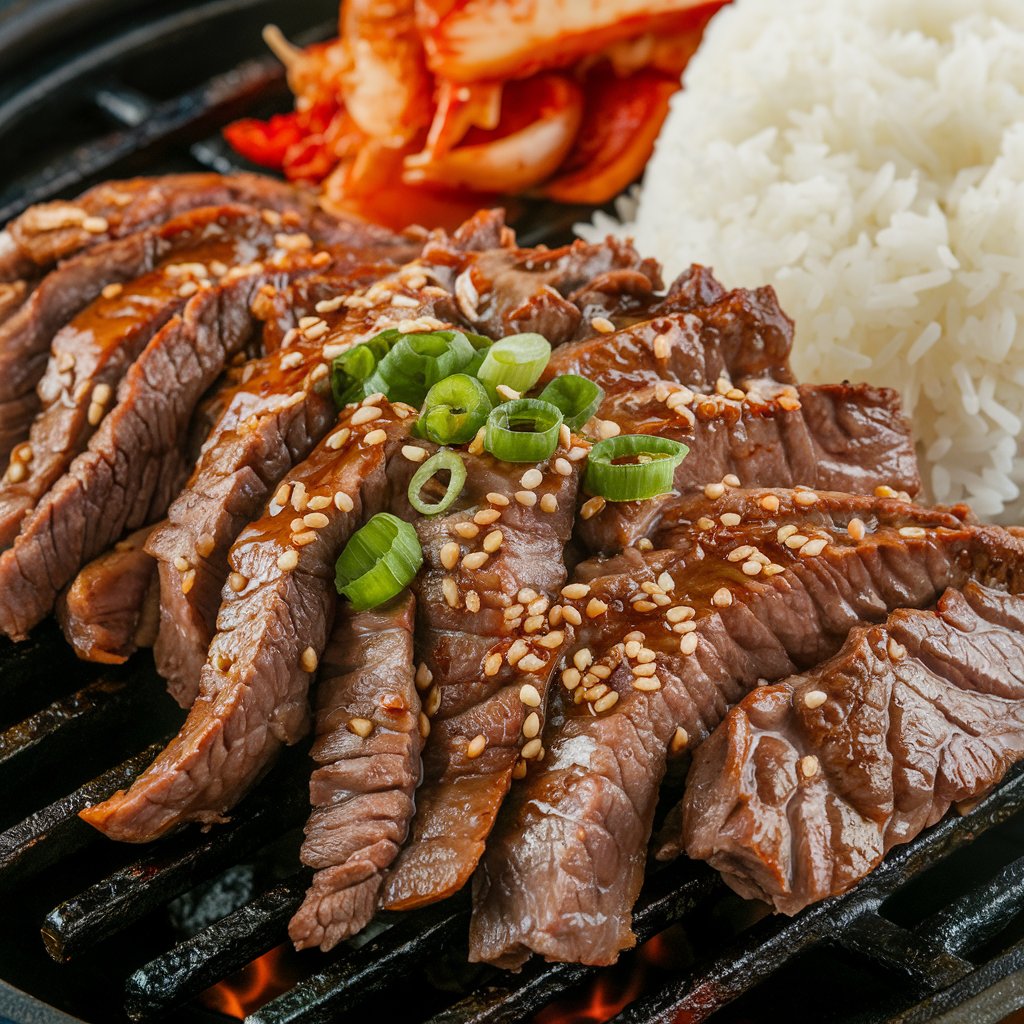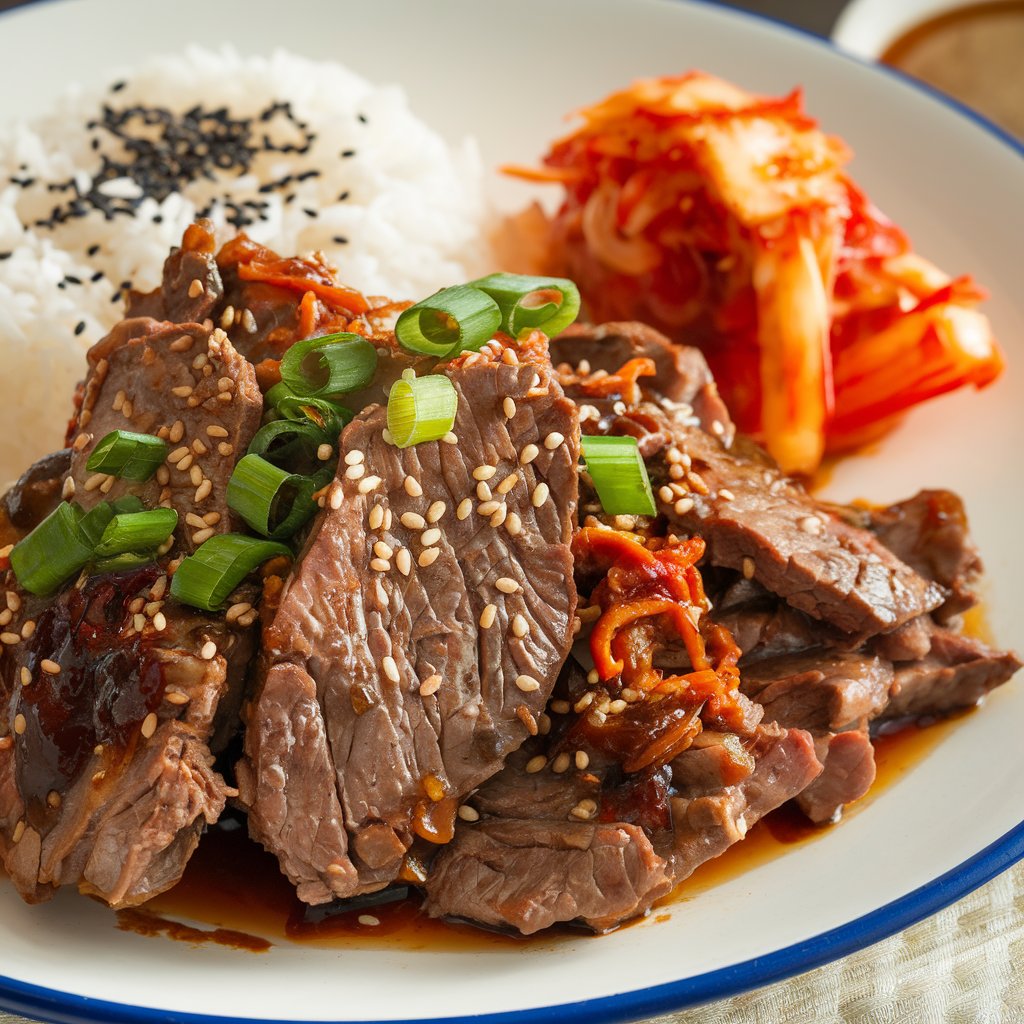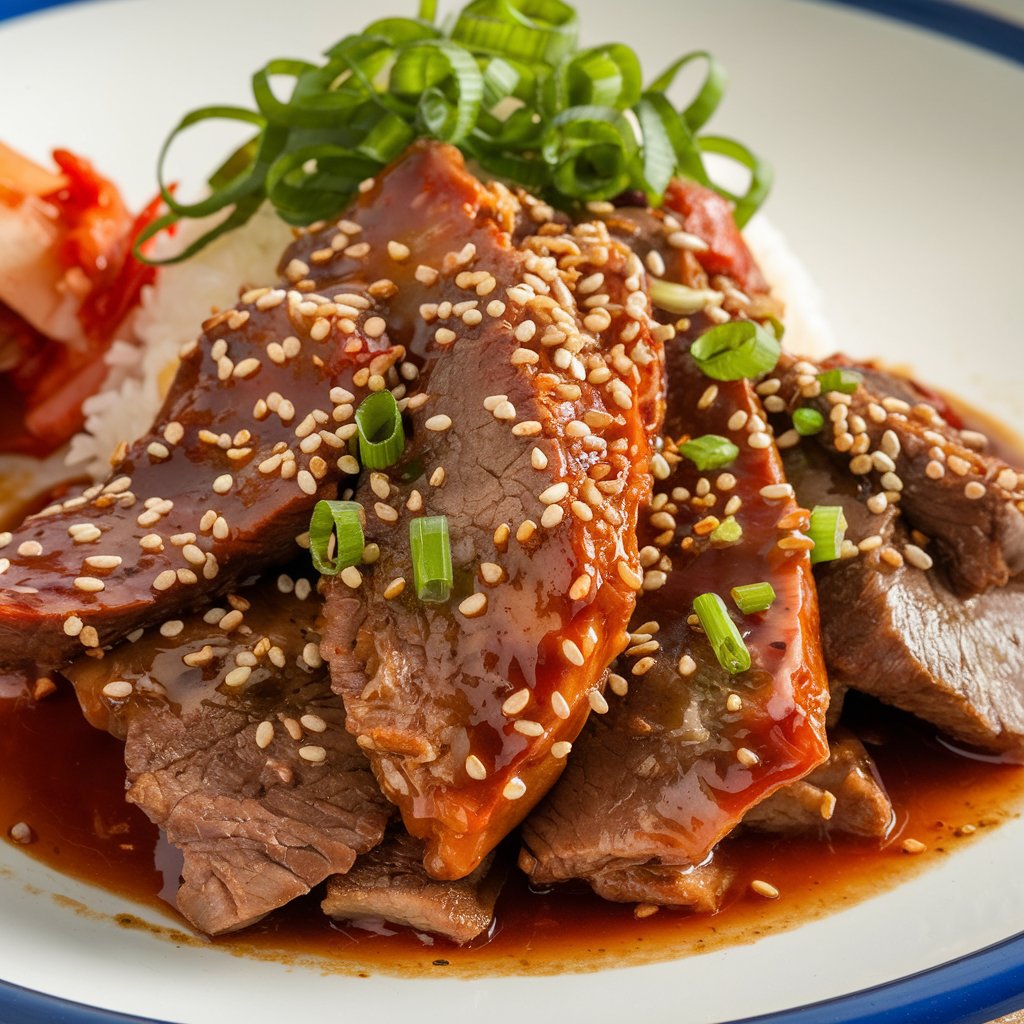If you’re craving a delicious, savory meal that’s packed with flavor, look no further than Korean beef recipes! 🥩 Known for their sweet and savory balance, tender meat, and mouthwatering aroma, Korean beef dishes are a cornerstone of Korean cuisine. From the popular bulgogi to the juicy galbi, these recipes bring together simple ingredients to create complex, restaurant-quality flavors at home.
In this guide, you’ll learn everything you need to know to make the perfect Korean beef recipe, including the ingredients, step-by-step instructions, popular variations, and tips to avoid common cooking pitfalls. Let’s dive in and explore the vibrant world of Korean beef dishes! 🌟
Introduction
Korean cuisine is celebrated worldwide for its bold flavors, intricate preparation methods, and deep cultural roots. Among the many dishes in this culinary treasure trove, Korean beef recipes stand out for their versatility and global appeal. Whether served as a main dish or part of a Korean barbecue feast, these recipes transform humble ingredients into unforgettable meals.
But what makes Korean beef recipes so special? It’s the perfect harmony of flavors—salty soy sauce, sweet brown sugar, tangy rice vinegar, and aromatic sesame oil—all wrapped around tender, juicy beef. Add to that the spice of gochujang (Korean chili paste) and the nuttiness of sesame seeds, and you’ve got a dish that’s impossible to resist.
Table of Contents
Understanding Korean Beef Recipes
What Is Korean Beef?
At its core, Korean beef refers to dishes made with beef as the primary ingredient, prepared using traditional Korean marinades and cooking methods. The beef is typically thinly sliced or cut into bite-sized pieces, which allows it to soak up the flavorful marinades and cook quickly. Popular variations include bulgogi (grilled marinated beef) and galbi (short ribs).
Korean beef recipes are beloved not just for their taste but for their versatility. They can be grilled, pan-fried, or slow-cooked, making them a fantastic choice for weeknight dinners or celebratory gatherings. Pair these dishes with classic sides like kimchi, steamed rice, or pickled vegetables for a complete meal.
Key Ingredients for Authentic Korean Beef
The success of any Korean beef recipe lies in its ingredients. While the list is relatively short, each ingredient plays a critical role in building the dish’s signature flavor profile. Here’s what you’ll need:
Essential Seasonings and Sauces
- Soy Sauce: The base of most marinades, adding saltiness and depth.
- Sesame Oil: Provides a nutty aroma and enhances the overall flavor.
- Brown Sugar or Honey: Balances the saltiness with a touch of sweetness.
- Garlic and Ginger: Infuses the dish with warmth and spice.
- Gochujang (Korean Chili Paste): Adds heat and a hint of smokiness.
- Rice Vinegar: A splash of tanginess to brighten the flavors.
Best Cuts of Beef for Korean Recipes
While you can use almost any cut of beef, these are the best options for achieving authentic results:
- Ribeye: Perfect for grilling or stir-frying due to its marbling.
- Sirloin: Leaner but still tender, ideal for bulgogi.
- Short Ribs: Used for galbi, offering a rich, hearty texture.
- Brisket: Works wonderfully in slow-cooked recipes.

Step-by-Step Guide to Cooking Korean Beef
Cooking Korean beef is both an art and a science. Follow these steps to recreate the authentic flavors of Korean cuisine in your own kitchen.
Preparing the Marinade
The marinade is the heart of any Korean beef recipe. Combine the following ingredients in a bowl:
- 1/2 cup soy sauce
- 3 tablespoons brown sugar
- 2 tablespoons sesame oil
- 1 tablespoon minced garlic
- 1 teaspoon minced ginger
- 1 tablespoon gochujang
- 1/2 teaspoon ground black pepper
Whisk these ingredients until well-blended, and let it sit for a few minutes to allow the flavors to meld together. Korean Beef Recipe
Marinating the Beef for Maximum Flavor
- Slice the Beef: Thinly slice your chosen cut of beef against the grain. This ensures tenderness.
- Coat the Beef: Add the beef to the marinade, ensuring each piece is well-coated.
- Refrigerate: Cover and refrigerate for at least 2 hours or overnight for deeper flavor penetration.
Pro Tip: Short on time? Use a fork to lightly pierce the beef before marinating to help the flavors penetrate faster. ⏱️
Cooking Techniques for Korean Beef
The method you choose can make a big difference in the final dish. Here are three popular techniques:
Pan-Frying Method
- Heat a tablespoon of sesame oil in a pan over medium heat.
- Add the marinated beef and cook for 2-3 minutes on each side until caramelized.
Grilling for Smoky Flavors
- Preheat a grill or grill pan.
- Cook the beef for 4-5 minutes on each side, brushing with marinade occasionally.
Slow Cooking for Tender Beef
- Place the marinated beef in a slow cooker.
- Cook on low heat for 6-8 hours until the beef is tender and infused with flavor.
Popular Variations of Korean Beef
Korean beef recipes offer an incredible range of flavors and textures, thanks to the various ways they can be prepared. Here are some of the most popular variations that highlight the versatility of this dish. Korean Beef Recipe
Bulgogi: Sweet and Savory Korean BBQ
Bulgogi, which means “fire meat,” is one of the most well-loved Korean dishes worldwide. It’s characterized by thinly sliced beef marinated in a sweet and savory sauce, then grilled or stir-fried to perfection.
- Flavor Profile: Bulgogi combines the saltiness of soy sauce, the sweetness of brown sugar, and the nuttiness of sesame oil.
- Preparation: Traditionally cooked on a grill, it’s equally delicious when stir-fried in a hot pan. Add vegetables like carrots, onions, and mushrooms for a balanced meal.
- Pro Tip: Use ribeye or sirloin for the most tender and flavorful bulgogi. Marinate overnight for best results.
Galbi: Korean Short Ribs Delight
Galbi, or Korean-style short ribs, is another classic that’s perfect for barbecue lovers. The ribs are marinated in a similar mix of soy sauce, garlic, sugar, and sesame oil, but the addition of grated Asian pear gives galbi a unique sweetness.
- Flavor Profile: Rich, smoky, and slightly fruity.
- Preparation: Best cooked over an open flame to achieve a slightly charred, caramelized crust.
- Pro Tip: Ask your butcher for “LA-style” ribs, which are cut thinly across the bone for faster cooking.
Spicy Korean Beef Stir-Fry
If you like a kick of heat, try the spicy Korean beef stir-fry. Made with gochujang and sliced beef, this dish is perfect for spice enthusiasts.
- Flavor Profile: Spicy, savory, and slightly sweet.
- Preparation: Stir-fry marinated beef in a hot wok with vegetables like bell peppers, onions, and zucchini. Finish with sesame seeds and green onions for garnish.
- Pro Tip: Adjust the spice level by controlling the amount of gochujang in the marinade.
Tips and Tricks for Perfect Korean Beef
Want to make sure your Korean beef recipe turns out perfectly every time? These tips and tricks will help you elevate your cooking game.
Achieving the Perfect Balance of Sweet and Savory
The hallmark of a great Korean beef dish is its balance of flavors. Here’s how to nail it:
- Sweetness: Use brown sugar, honey, or even grated Asian pear for natural sweetness.
- Saltiness: Soy sauce is key, but don’t overdo it. Add gradually and taste as you go.
- Acidity: A splash of rice vinegar or lemon juice adds brightness and keeps the flavors from being too heavy. Korean Beef Recipe
“Cooking Korean beef is like creating a symphony—every ingredient needs to play its part in harmony.” 🎶

Pairing Korean Beef with Sides and Drinks
A good side dish can transform your meal into a full-on feast. Pair your Korean beef with these classics:
- Kimchi: The tangy, spicy fermented cabbage cuts through the richness of the beef.
- Steamed Rice: A must-have to soak up all the delicious juices.
- Pickled Radish: Adds a refreshing crunch to the meal.
- Soju or Beer: Popular Korean alcoholic beverages that complement the smoky, savory flavors.
Common Challenges and Solutions
Cooking Korean beef isn’t difficult, but it does come with its own set of challenges. Let’s tackle them head-on.
Preventing Tough or Chewy Beef
Nobody likes tough beef! Follow these tips to keep your meat tender:
- Slice Against the Grain: Cutting the beef this way shortens the muscle fibers, making each bite more tender.
- Don’t Overcook: Thin slices cook quickly, so keep an eye on them. Overcooking can dry out the beef.
- Marinate Properly: The marinade not only adds flavor but also tenderizes the meat.
Avoiding Overpowering Sauces
While the marinade is crucial, too much of it can overwhelm the dish:
- Use Balanced Proportions: Stick to the recipe ratios for soy sauce, sugar, and sesame oil.
- Don’t Over-Marinate: Marinating for too long can make the beef overly salty or soggy. Aim for 2–4 hours, or overnight for thicker cuts.
Frequently Asked Questions (FAQs)
Can I Substitute Ingredients?
Yes! While traditional ingredients are ideal, substitutions can work in a pinch:
- Soy Sauce: Swap with tamari or coconut aminos for a gluten-free option.
- Gochujang: Replace with a mix of red chili flakes, soy sauce, and a touch of sugar.
- Asian Pear: Use grated apple or pineapple for sweetness.
What’s the Best Way to Store Leftover Korean Beef?
- Refrigeration: Store in an airtight container for up to 3 days.
- Freezing: Freeze marinated but uncooked beef for up to 3 months. Defrost and cook as needed.
Cooking Techniques for Korean Beef
Cooking Korean beef is as versatile as it is delicious. Let’s explore the different methods you can use to create perfectly cooked Korean beef dishes, regardless of your equipment or skill level.
Pan-Frying Method
Pan-frying is a quick and convenient way to cook Korean beef. It’s ideal for small portions and ensures a beautifully caramelized exterior.
- Steps:
- Heat a nonstick skillet or cast-iron pan over medium-high heat.
- Add a tablespoon of sesame oil to the pan.
- Place the marinated beef slices in the skillet in a single layer. Avoid overcrowding the pan.
- Cook for 2–3 minutes on each side, or until the beef is browned and slightly crispy.
“The sound of beef sizzling in sesame oil is music to a chef’s ears!” 🎵
- Tip: Wipe the pan between batches to avoid burning leftover marinade residue.
Grilling for Smoky Flavors
Grilling brings out the smoky, charred essence of Korean beef, perfect for dishes like bulgogi or galbi.
- Steps:
- Preheat your grill or grill pan to medium-high heat.
- Lightly oil the grill grates to prevent sticking.
- Lay the marinated beef on the grill and cook for 3–5 minutes on each side, depending on the thickness.
- Brush the beef with leftover marinade for extra moisture and flavor during grilling.
- Tip: For an authentic Korean barbecue experience, serve grilled beef straight off the grill with dipping sauces and fresh lettuce wraps.
Slow Cooking for Tender Beef
Slow cooking is perfect for cuts like brisket or short ribs, which benefit from long, gentle cooking to become fall-apart tender.
- Steps:
- Place the marinated beef in a slow cooker.
- Add sliced onions and a splash of water or beef broth to prevent drying out.
- Cook on low for 6–8 hours or high for 3–4 hours.
- Garnish with sesame seeds and green onions before serving.
“Slow cooking is like giving the beef a spa day—it comes out relaxed, juicy, and tender!” 🧖♀️
Pairing Korean Beef with Sides and Drinks
No Korean beef meal is complete without the perfect accompaniments. Here are some ideas to round out your feast:
Traditional Korean Side Dishes (Banchan)
- Kimchi: The spicy, fermented cabbage pairs beautifully with the richness of beef.
- Steamed Rice: A neutral base that balances out the bold flavors.
- Japchae: Sweet potato noodles stir-fried with vegetables and soy sauce.
- Pickled Radish: A refreshing and crunchy side that adds acidity to the meal.
Ideal Drinks for Korean Beef
Pair your Korean beef dishes with these beverages to elevate the dining experience:
- Soju: Korea’s iconic distilled spirit that’s slightly sweet and easy to drink.
- Makgeolli: A slightly fizzy, milky rice wine that complements grilled dishes.
- Beer: A cold lager like Cass or Hite is perfect for washing down smoky barbecue flavors.
Frequently Asked Questions (FAQs)
Can I Prepare Korean Beef in Advance?
Absolutely! Korean beef recipes are great for meal prep. Here’s how:
- Marinate Ahead: Prepare the marinade and soak the beef in it the night before.
- Freeze for Later: Freeze uncooked marinated beef for up to 3 months. Thaw before cooking.
How Do I Adjust the Spice Level?
Not a fan of spice? Or perhaps you want more heat? Adjust the gochujang to your taste.
- Milder Option: Reduce or omit the gochujang and add a pinch of brown sugar for sweetness.
- Spicier Option: Add chili flakes or a spoonful of Korean chili powder (gochugaru) for an extra kick.
Conclusion
Korean beef recipes are the perfect blend of tradition, flavor, and versatility. Whether you’re making bulgogi, galbi, or a spicy stir-fry, you’ll find that these dishes are not only easy to prepare but also a guaranteed crowd-pleaser. With the right ingredients, cooking techniques, and a little practice, you can recreate the authentic flavors of Korean cuisine in your own kitchen.
So, why wait? Gather your ingredients, fire up the grill (or stovetop), and get ready to savor the delicious world of Korean beef recipes. 🍽️
“Cooking is love made visible—Korean beef recipes are proof of that!” ❤️

